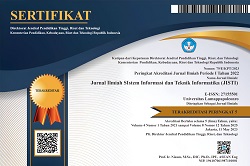Cash Flow Forecasting for Companies Listed on the Indonesia Stock Exchange Using the ARIMA Model
Abstract
Cash flow forecasting plays a crucial role in supporting financial stability and strategic decision-making for businesses. This study aims to analyze and forecast the operating cash flow of healthcare sector companies listed on the Indonesia Stock Exchange (IDX) using the ARIMA (Autoregressive Integrated Moving Average) model. The dataset consists of quarterly operating cash flows from 17 companies over the period 2020–2024. This research uses a quantitative approach with time series analysis. The modeling process includes stationarity testing, parameter identification, model training, and evaluation using MAPE, MAE, RMSE, and R-squared as performance metrics. The results indicate that all cash flow data are stationary, and the ARIMA models provide strong predictive performance, with MAPE values below 20% and R-squared consistently above 0.90. These findings suggest that the healthcare sector exhibits stable cash flow patterns and resilience to short-term fluctuations. The study concludes that ARIMA is an effective tool for short-term financial forecasting in the healthcare industry. The implications of this study suggest that the forecasting results can be used as a reliable basis for budget planning, liquidity management, and investment decision-making in healthcare companies.
Downloads
References
Firmansyah, M., Masrun, M., & Yudha S, I. D. K. (2021). Esensi perbedaan metode kualitatif dan kuantitatif. Elastisitas: Jurnal Ekonomi Pembangunan, 3(2), 156–159. https://doi.org/10.29303/ejep.v3i2.46
Gitman, L. J., Juchau, R., & Flanagan, J. (2015). Principles of managerial finance. Pearson Higher Education AU.
Gunawan, D., & Febrianti, I. (2023). Ethereum value forecasting model using Autoregressive Integrated Moving Average (ARIMA). International Journal of Advances in Social Sciences and Humanities, 2(1), 29–35. https://doi.org/10.56225/ijassh.v2i1.151
Hassyddiqy, H., & Hasdiana, H. (2023). Analisis peramalan (forecasting) penjualan dengan metode ARIMA (Autoregressive Integrated Moving Average) pada Huebee Indonesia. Data Sciences Indonesia (DSI), 2(2), 92–100. https://doi.org/10.47709/dsi.v2i2.2022
Juliani, R. H., & Muslihat, A. (2021). Influence of profit and cash flow on financial distress conditions. Jurnal Ilmu Manajemen Profitability, 5(2), 327–339.
Kieso, D. E., Weygandt, J. J., Warfield, T. D., Wiecek, I. M., & McConomy, B. J. (2019). Intermediate Accounting (Vol. 2). John Wiley & Sons.
Montgomery, D. C., Jennings, C. L., & Kulahci, M. (2015). Introduction to time series analysis and forecasting. John Wiley & Sons.
Petropoulos, F., Apiletti, D., Assimakopoulos, V., Babai, M. Z., Barrow, D. K., Taieb, S. B., ... & Ziel, F. (2022). Forecasting: Theory and practice. International Journal of Forecasting, 38(3), 705–871. https://doi.org/10.1016/j.ijforecast.2021.11
Putra, A. L., & Kurniawati, A. K. (2021). Analisis prediksi harga saham PT Astra International Tbk menggunakan metode Autoregressive Integrated Moving Average (ARIMA) dan Support Vector Regression (SVR). Jurnal Ilmiah Komputasi, 20(3), 417–424. http://dx.doi.org/10.32409/jikstik.20.3.2732
Ramadhani, F., Sukiyono, K., & Suryanty, M. (2020). Forecasting of paddy grain and rice’s price: An ARIMA (Autoregressive Integrated Moving Average) model application. SOCA: Jurnal Sosial, Ekonomi Pertanian, 14(2), 224. https://doi.org/10.24843/soca.2020.v14.i02.p04
Salsabilah, F., Setiawan, M. F., & Whardani, S. P. (2022). Faktor-faktor yang mempengaruhi perencanaan sumber daya manusia: Lingkungan eksternal, keputusan-keputusan organisasional, persediaan karyawan (Literature Review MSDM). Jurnal Ilmu Hukum, Humaniora dan Politik, 2(2), 141–149.
Tak, A., Dia, S., Dia, M., & Wehner, T. C. (2021). Indian COVID-19 dynamics: Prediction using Autoregressive Integrated Moving Average modelling. Scripta Medica (Banja Luka), 52(1), 6–14. https://doi.org/10.5937/scriptamed52-29893
Tolla, S. D., & Vendy, V. (2024, September). Developing a predictive model to predict cash flow using time series analysis. In Proceedings of International Conference on Economics Business and Government Challenges (Vol. 7, No. 1, pp. 280–290).
Zhu, D., Zhou, D., Li, N., & Han, B. (2022). Predicting diabetes and estimating its economic burden in China using Autoregressive Integrated Moving Average model. International Journal of Public Health, 66, 1–8. https://doi.org/10.3389/ijph.2021.1604449
JISTI
















